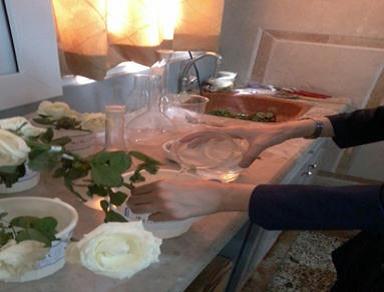Malihe Shahreki Nader, Yahya Dehghani Shuraki, and Hamid Reza Mobasser from the different institute of the Iran. wrote a research article about, Aluminum Sulfate and Copper Sulfate Impact on Rosa hybrida, entitled, Influence of aluminium sulfate and copper sulfate on some characteristic in Rosa hybrida. This research paper published by the Journal of Biodiversity and Environmental Sciences | JBES.an open access scholarly research journal on Biodiversity, under the affiliation of the International Network For Natural Sciences | INNSpub. an open access multidisciplinary research journal publisher.
Abstract
Flowers play a vital role in angiosperm reproduction; they are often pigmented and or perfumed to attract pollinators. However, despite its irreplaceable ecological role, the flowers are energetically expensive to maintain beyond their useful life, and therefore have a limited life-span that is usually taken away after pollination; causing senescence syndrome. Aluminum sulfate can decrease cut rose petal acidity and cause fixation of anthocyanin pigments and increase cut rose flowers vase. The role of aluminum sulfate to increase the vase life of cut flowers is not limited to lowering the pH of vase solution. The experiment was conducted at the research laboratory of education complex of zahedan (in iran). Laboratory lighting was provided by fluorescent lamps. The field experiment was laid out in randomized complete block design with factorial design with four replications. Analysis of variance showed that the effect of aluminium sulfate and copper sulfate on all characteristic was significant.
Read more: Cogongrass Extract: Inhibiting Anthracnose in Bird’s Eye Chili | InformativeBD
Introduction
Flowers play a vital role in angiosperm reproduction; they are often pigmented and or perfumed to attract pollinators. However, despite its irreplaceable ecological role, the flowers are energetically expensive to maintain beyond their useful life, and therefore have a limited life-span that is usually taken away after pollination; causing senescence syndrome. Senescence of flower is a complex process, so often researchers mainly concentrate on changes occurring during petal senescence. Petals provide an excellent model system for the study of fundamental aspects of senescence (Rogers, 2006; Desai et al., 2012).
Senescence is a highly regulated final event of flower development that bears hallmarks of programmed cell death (PCD), resulting in colour changes, petal wilting, abscission of whole flower and flower parts with various physiological, biochemical and ultrastructural changes (Voleti et al., 2000; Wagstaff et al., 2003; Jones et al., 2005; Tripathi & Tuteja, 2007; Seo et al., 2009; Ichimura, 2010; Shahri, 2011). Roses are one of the most important cut flowers in the world (Şirin, 2011) and extremely perishable (Figueroa et al., 2005) as well as other cut flowers such as Eustoma grandiflorum (Hojjati et al., 2007; Farokhzad et al., 2005), Gerbera jamesonii (Nair et al., 2003). Short postharvest vase life is one of the most important problems in cut flowers (Zamani et al., 2011).
So consider to maintaining postharvest quality of cut flowers is critical for preventing offlower post harvest losses. Senescence which is the main factor affecting on flower quality can be induced by several per and post- harvest factors e.g., water stress (Sankat and Mujaffar, 1994), amount of carbohydrates (Coorts, 1973; Ketsa, 1989), microorganisms (Van Doorn and Witte, 1991), ethylene effects (Wan & Miller, 2003) as documented in carnation and roses (Mayak and Halevy, 1980; Halevy and Mayak, 1981; Quesada and Valpuesta, 2000) and Lisianthus (Farokhzad et al., 2005; Hojjat et al., 2007) and cultivar differences, season, development stage at harvest and cultivated conditions (Doel and Wilkins, 1999). Application of some germicides has been suggested to prevent rapid proliferation of microorganisms and to decrease the longevity of cut flowers. Cut flower species respond to germicides variously.
Al2(SO4)3 has been
recommended for maintaining the vase life of several cut flowers (Liao et al.,
2001) and is used as an antimicrobial compound in commercial preservative
solutions (Ichimura et al., 2006). Aluminum sulfate acidifies vase solution,
diminishes bacterial proliferation and enhances water uptake (Tjeerd and Jaap,
2003; Hassanpour Asil et al., 2004). Roses and can be caused by physiological
occlusion due to plant itself, microorganisms or air embolism (Van Doorn et
al., 1989).
Also aluminum sulfate
can decrease cut rose petal acidity and cause fixation of anthocyanin pigments
and increase cut rose flower‟s vase life (Put Henriette et al., 1992; Tjeerd
and Jaap, 2003; Hassanpour Asil et al., 2004). The role of aluminum sulfate to
increase the vase life of cut flowers is not limited to lowering the pH of vase
solution. Its effect is based at least in part, on its action as an
antimicrobial agent in the solution (Liao et al., 2001).
More study is necessary
to determine the effect of aluminum sulfate on vase life of cut flowers,
specially cut roses as one of the most important cut flowers in the world. Van
Meetereu et al. (2001) suggested that it must be used a combination of calcium
chloride, sodium carbonate and copper sulfate solution as a basic standard for
the preservative solution. Motivation and aims of the study are Influence of
aluminium sulfate and copper sulfate on some characteristic in rosa hybrid.
Reference
Desai R, Patel R,
Mankad A. 2012. Petal senescence in cut Tagetes erecta L. flowers: Role of
phenolics. International Journal of Science Environment and Technology. 1, 485
– 490.
Ichimura K, Shimizu H,
Goto R. 2009. Ethylene production by gynoecium and receptacle is
associated with sepal abscission in cut Delphinium flowers. Postharvest Biology
and Technology. 52, 267–272.
Jones ML, Chaffin GS,
Eason JR, Clark DG. 2005. Ethylene sensitivity regulates proteolytic
activity and cysteine protease gene expression in petunia corollas. Journal of
Experimental Botany. 56, 2733-2744.
Rogers HJ. 2006.
Programmed cell death in floral organs: How and why do flowers die. Annals of
Botany journal. 97, 309–315.
Shahri W, Tahir I,
IslamST, Bhat MA. 2011. Physiological and biochemical changes associated
with flower development and senescence in so far unexplored Helleborus
orientalis Lam. cv. Olympicus. Physiology and Molecular Biology of Plant. 17, 33–39.
Seo S, Kang SW, Shim
IS, KimW, Fujihara S. 2009. Effects of various chemical agents and early
ethylene production on floral senescence of Hibiscus syriacus L. Plant Growth
Regulation. 57, 251–258.
Tripathi SK, Tuteja N. 2007.
Integrated signaling in flower senescence. Plant signaling and Behavior.
Journal of Experimental Botany. 2, 437-446.
Voleti SR, Singh V,
Arora A, Singh N, Kushwaha SR. 2000. Physiology of flower senescence in
floriculture crops. In A. Hemantaranjan (Ed.). Advances in Plant
Physiology. 12, 423-439.
Wagstaff C, Leverentz
MK, Griffiths G, Thomas B, Chanasut U, Stead AD. 2002. Cysteine protease
gene expression and proteolytic activity during senescence of Alstroemeria
petals. Journal of Experimental Botany. 53, 233-240.
Doel JM, Wilkins HF. 1999.
Floriculture: principles and species. Prentic Hall, inc New Jersy. Physiology
and Molecular Biology of Plant. 17, 33–39.
Farokhzad A, Khalighi
A, Mostofi Y, Naderi R. 2005. Role of Ethanol in the Vase Life and
Ethylene Production in Cut Lisianthus (Eustoma grandiflorum Mariachii. cv.
Blue) Flowers. Advances in Plant Physiology. 1, 309-312.
Hojjati Y, Khalighi A,
Farokhzad AR. 2007. Chemical Treatments of Eustoma Cut Flower Cultivars
for Enhanced Vase Life. Journal of Agriculture and Social Sciences. 3(3), 75-78.
Halevy AH, Mayak S. 1981.
Senescence and postharvest physiology of cut flowers. Part 2. Hortic. Annals of
biological reaserach. 3, 59-143.
Ketsa S. 1989.
Vase life characteristics of inflorescences of dendrobium Pompadour. Journal of
Experimental Botany. 64, 611–643.
Nair SA, Singh V,
Sharma TV. 2003. Effect of chemical preservatives on enhancing vase-life
of gerbera flowers. Advances in Plant Physiology. 41, 56-58.
Vandoorn WG, WitteYE. 1991.
The mode of action of bacteria in the vascular occlusion of cut rose flowers.
Acta Horticulture journal. 298, 165-176.
Wu M, Lorenzo Z,
Saltveit ME, Reid MS. 1992. Alcohol and carnation senescence. Journal of
Experimental Botany. 27, 136-138.
Zamani S, Kazemi M,
Aran M. 2011. Postharvest life of cut rose flowers as affected by
salicylic acid and glutamin. World applied science Journal. 12(9), 1621-1624.
Şirin U. 2011.
Effects of different nutrient solution formulations on yield and cut flower
quality of gerbera (Gerbera jamesonii) grown in soilless culture system.
African Journal of Agricultural Research. 6(21), 4910-4919.
Ichimura K, Ueyama S. 1998.
Effect of temperature and application of aluminum sulfate on the postharvest
life of cut rose flowers. Bulletin of the National Research Institute of
Vegetables Ornamental Plants and Tea. World applied science Journal 13, 51-
60.
Liao LJ, Lin YH, Huang
KL, Chen WSh, Cheng YM. 2000. Postharvest life of cut rose flowers as
affected by silver thiosulfate and sucrose. African Journal of Agricultural
Research. 41, 299 – 303.
Put Henriette MC,
Clerkx Anke CM, Boekestein A. 1992. Aluminum sulphate restricts migration
of Bacillus subtilis in xylem of cut roses: a scanning electron microscope
study. Scientia Horticulture journal. 51, 261- 274.
Van Doorn WG, Schurer
K, De Witte Y. 1989. Role of endogenous bacteria in vascular blockage of
cut rose. Journal of Plant Physiology. 134, 375-381.
Hassanpour Asil M,
Hatamzadeh A, Nakhai F. 2004. Study on the effect of temperature and
various chemical treatments to increase vase life of cut rose flower “Baccara”.
Research Journal of Guilan Agriculture Faculty. 1(4), 121- 129.
Source : Influence of aluminium sulfate and copper sulfate on some characteristic in Rosa hybrida












%20in%20full.JPG)


0 comments:
Post a Comment